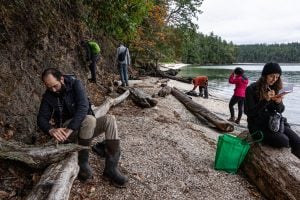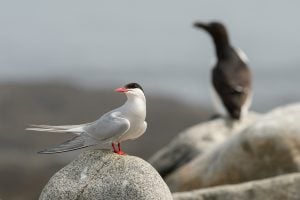
Wildlife
Hide and seek: The race to save the Vancouver Island Marmot
In the field with researchers and volunteers scrambling to save Canada’s most endangered mammal
- 2418 words
- 10 minutes
Travel
Complete with digitally painted photographs, Bill Arnott’s new travel memoir explores British Columbia’s southern Gulf Islands and Vancouver Island

First things first. This is a part of the world that I love. Vancouver Island and its surrounding archipelago, British Columbia’s Gulf Islands, remain one of the planet’s most magical regions. When RMB publisher Don Gorman asked if I’d write a memoir about time spent here and include original visual art, not only was I delighted, but eager. Truth be told, I’d have created it anyway. Only now can we experience it together. Which is an incredible privilege, sharing vignettes and digitally painted photos, discovering new and familiar sites: forest, sea, the lands of Indigenous Nations. I’ve included a note as to names and transliteration, doing my best to accurately relay regional narratives. The result, I feel, is a time-bending present day journey, imagery of place and people, recollection of past while glimpsing the future. Meanwhile, the star of this show, the Island, in fact each island and coast, continues to reveal remarkable, intimate secrets. It’s a sensory excursion I’m grateful and pleased to share. A season I hope to enjoy.





Ten thousand horses rumble to life. With a diesel vibration, water churns into chop and a blue and white ferry shoves us into the strait, in the direction of Vancouver Island. On the other side of the water, Nanaimo. Snuneymuxw. Coast Salish land. A sense of connection is what I feel, gazing through open steel portals. The horses pick up their pace, trot to canter, as a ripple ricochets through rivets and railings. The result, a feeling of departure, and possibility.
It’s what I felt as a child, venturing into hills behind our home on a north arm of Okanagan Lake, bubbles of land carved by glaciers, the big lake fed by a narrow, deep creek. It was that sense of departing on a grand adventure that’s never gone away, each time I’m off somewhere new. Even places familiar, for that matter, seen for the first time again. As a kid I’d pick a stick from the deadwood, pry my way through barbed wire like a wrestler entering the ring, and climb. Over the hill cattle grazed, and the land beyond that was orchard. It always smelled dry. Of course, I’d take care, watching for cow pies, rattlesnakes, and undetonated mortars. An army camp was across the lake, and a few decades ago the arid grass banks served as target practice, bombs lobbed across the water.
Now, aboard a westbound ferry, the day’s rolling out somewhat dreamily. The ferry is full, the first at capacity in months, and the crew’s a bit overwhelmed by an onslaught of passengers awaiting their Triple-O burgers, like kids released into summer following a particularly miserable winter. A winter that’s lasted two years.
Our vehicle is on an upper deck berth aboard the MV Queen of Cowichan and we’ve chosen to stay put, hunkering in our well-worn car with the aroma of road trips, fast food, and bare feet. Meanwhile, Horseshoe Bay’s showing off its photogenic cliffs and arbutus, copper-pistachio peelings of bark as though they’ve been outdoors too long, overdue for a coating of sunscreen. Bowen Island rises from sun-dappled water like a child’s likeness of a surfacing whale, a round hump of a back, the only things missing being flukes and a blowhole waterspout. Sounds and smells mingle, wafting amidst cars: cell phone chatter, sneaky second-hand smoke, laughter, coffee, the vibrating basso of ferry engine, and the inevitable bleat of a car alarm, its owner nowhere to be found.
Tatters of cloud stream past as we venture west by southwest. Midway across the Salish Sea we pass our doppelganger going the opposite way, the visual striking. A weather front’s hanging in place at the halfway point of the crossing, a vertical line of rain and smudgy dark cloud, monochrome seascape in a rinse of blue-grey. I watch the ferry pass through the wall of weather, easing from dark to light, like Dorothy stepping from blustery Kansas to the technicolour of Oz. Unbeknownst to me we’re making our very own leap through a time-bending lens, as we’ve come for five weeks, but will go home in three months from now.
Excerpted with permission from A Season on Vancouver Island, published by Rocky Mountain Books.
Are you passionate about Canadian geography?
You can support Canadian Geographic in 3 ways:

Wildlife
In the field with researchers and volunteers scrambling to save Canada’s most endangered mammal

People & Culture
Naming leads to knowing, which leads to understanding. Residents of a small British Columbia island take to the forests and beaches to connect with their nonhuman neighbours

Wildlife
On New Brunswick’s Machias Seal Island, predatory gulls are pushing endangered Arctic tern colonies to the brink, creating a dilemma for wildlife managers

Places
Exploring the wonders of the Pacific and the unique ecosystems surrounding Vancouver Island and the Gulf Islands with author and photographer Sara Ellison